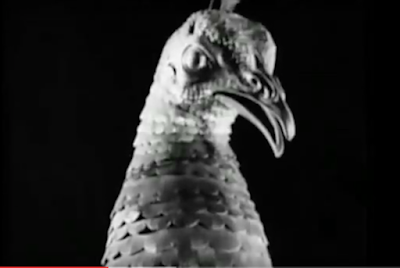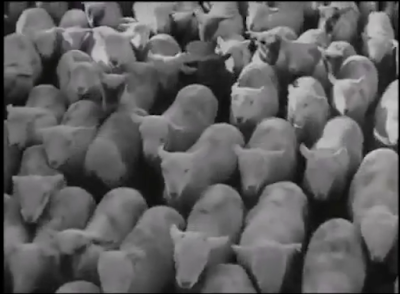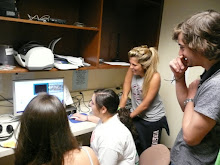THEMATIC MONTAGE (also known as "intellectual" montage and "Dynamic Editing"): A type of editing which, through the juxtaposition or collision of contrasting shots or sequences, generates ideas in the viewer's mind which are more than the meaning of the shots by themselves. It stresses the association of ideas without regard to unity in space and time. These "glimpses" take place outside of the narrative but add to the character development, suspense, mood, of a scene or they probe depths of the human condition. These visuals can be rather symbolic or abstract.
The shots, by themselves, don't hold the same power as they do side by side. In fact, they may hold no meaning at all by themselves. Assembled together, they serve the filmmaker's vision by creating rich meanings.
KULESHOV EFFECT: A type of editing that invites the viewer to infer meaning from dissimilar clips placed side by side. This is a mental exercise on the part of the viewer. It is the foundation on which thematic montage is built. The meaning or interpretation is often derived from making assumptions about what a character is thinking or feeling. The Kuleshov effect was demonstrated by Soviet filmmaker Lev Kuleshov in the 1910s and 1920s. Scroll to the bottom of this page for examples of the Kuleshov Effect.
Eisenstein's lion statue montage from Battleship Potemkin (silent, 1925)
Cow slaughter scene from Eisenstein's Strike (silent, 1925). Warning: this is a graphic slaughter.
In Charlie Chaplin's "Modern Times" (silent, 1936), factory workers are likened to sheep going to slaughter. https://youtu.be/S7243HDKh-s?t=54s
In another example of thematic editing, Hitchcock uses a visual pun here for sex when he shows a train going into a tunnel in the 1959 film North by Northwest. Not truly a "montage," but definitely a visual metaphor.
Visual metaphors for sex in movies abound, as can be seen in this example from Anchorman (2004), wherein the characters are actually part of the metaphorical shots, shown riding on unicorns.
The Naked Gun 2 1/2 (1991) combined every possible visual metaphor for sex and cut them into one sex scene.
The Human Condition Examples:
The Human Condition Examples:
In Run, Lola, Run (German, 1998), Lola runs to different relatives to beg them for a large quantity of money to help her boyfriend get out of a jam. She runs by people who aren't characters in the movie, but nonetheless, we see "photo montages" of their lives. These photo montages are symbolic shots that are not part of the space and time of the narrative (they happen outside of our story and are therefore non-diegetic). Go to 2:30 in this clip (above) to see one example. Other examples: lady in hall: https://www.youtube.com/watch?v=7UjGtkIfYv4; lady with baby montage #2: https://www.youtube.com/watch?v=ZueKltTQXOk; a guy gets beat up:
https://www.youtube.com/watch?v=grutWxsQet0 These individuals stand in for humanity as we get the impression that everyone's fate is uncertain and left to chance.
Reality shows make use of visual metaphors, too, as seen here in the editing of the infamous "Clare confides in a raccoon" scene from Bachelor in Paradise (2014). Clare is obviously talking to an off-screen producer, a production crew member who remains hidden to maintain the illusion of the show. But here, the editor cleverly intercuts a raccoon (and adds raccoon sounds), making it appear that the raccoon is listening. The metaphorical aspect comes into play when one considers that even a lowly, chattery "scavenger" species like a raccoon can't relate to the foolish antics of the whiney contestant on this sometimes sordid show.
Audio metaphor:
Reality shows like The Bachelor love to add audio effects, like this clip wherein we hear the sound of a bird of prey as the villainess is talking about a weaker character she hopes will be eliminated from the competition soon. The bird we are seeing here clearly did not make this noise, but the audio joke adds to the tension and the enjoyment of the conflict for the viewer.
The Kuleshov Effect EXAMPLES:
In the original experiment that Lev Kuleshov conducted, he showed an actor whose face is rather blank but edited it with a variety of shots (food, a woman, a girl in a coffin). Audiences inferred that he was hungry (if they saw the clip of the man paired with the soup), he was lustful (if paired with the woman), or sad (if paired with the dead girl). You, the viewer, has to infer what the man is feeling by the way the shots have been placed together. The actor does not give you any help in creating meaning.
Kuleshov Effect example: Notice here how the same clip of Henry Fonda's face is repeated but is paired with different shots each go-round. He seems to be lusting for food in one pair and in another, lusting for sex. Although the actor's face is very animated, it's the same throughout the pairings with various clips, leaving the viewer to create meaning.
Kuleshov Effect example: notice how, in this student film, the actress maintains a blank facial expression and different scenes are presented to her: an ice cream cone, a puppy in a pet store window, and a homeless beggar. Notice how you, the viewer, infer what she is thinking or feeling, even though the actress doesn't change expression throughout the video.
























No comments:
Post a Comment